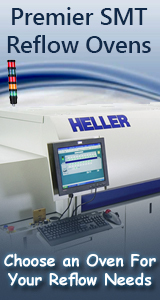> Hello everyone! > > I'm a student of electrical > engineering currently working on a thesis for my > BSc degree. It will be about post reflow AOIs and > AXIs, and I'd kindly like to ask you for some > help with it. > > I would like to know if there > are any standards according to a line relase of > an AOI/AXI for continous production, so basically > - how do you test your machine? Do you do an > (attribute) gauge R&R? Do you make bad samples > for a test? How many, what failures? If there > are any standards where can I read about them? If > there are none please help me out: what do you > guys do when you do a line release? > > Thanks in > advance, and please forgive my poor English, I'm > not a native speaker. > > Ismir
I would like to know if there re any standards according to a line relase of an AOI/AXI for continous production, so basically - how do you test your machine? Ismir, I may be stepping in it here, but I am aware of no "standards" for implementation of post reflow AOI or AXI. I'm sure the brothers here will correct me if I am wrong.
Do you do an(attribute) gauge R&R? We do something similar. When setting up our AOI programs, we work with a "golden" PCB first when debugging the programs. Acceptance criteria are adjusted (matching scores)and the PCB is run through the machine repeatedly while adjusting acceptance criteria downward. At some point the machine interprets the artificial threshold and calls out a defect. Once this defect threshold has been established with the golden PCB, the PCB is run through the machine repeatedly to insure that the defect and defect rate is stable. In our evaluation of various machines we used 25 passes through the machine to gauge repeatability. The defect threshold is then raised to eliminate the defect, then the PCB is again run through the machine for 25 passes, and we expect to see no defects.
Do you make bad samples for a test? We do exactly that. Whatever soldering defect we are looking for, we use an existing PCB, and create to our best ability, an example of that type of defect. Solder bridge, incorrect polarity, component misalignment, missing part, extra part, insufficient solder, lifted lead, BGA planarity. These defects types are mapped onto a PCB and we again repeatedly run the PCB through the AOI machine to ensure the defect rate is stable.
How many, what failures? See above. In most cases the AOI machine has built in algorithms that will detect most defects using standard settings, fine tuning of the programs is where the artistry comes in.
Hope this is of some help to your questions.
'hege
reply »
![]() Hello everyone!
I'm a student of electrical engineering c...
- Sep 16, 2008
by
Ismir
Hello everyone!
I'm a student of electrical engineering c...
- Sep 16, 2008
by
Ismir
![]()
![]()
![]() > Hello everyone!
>
> I'm a student of electrica...
- Sep 16, 2008
by
Hegemon
> Hello everyone!
>
> I'm a student of electrica...
- Sep 16, 2008
by
Hegemon
![]()
![]() Dear Hegemon,
I'm very grateful for your help. There is o...
- Sep 18, 2008
by
Ismir
Dear Hegemon,
I'm very grateful for your help. There is o...
- Sep 18, 2008
by
Ismir
![]()
![]()
![]() You are on the right track Ismir. Essentially however, as t...
- Sep 22, 2008
by
Hegemon
You are on the right track Ismir. Essentially however, as t...
- Sep 22, 2008
by
Hegemon







